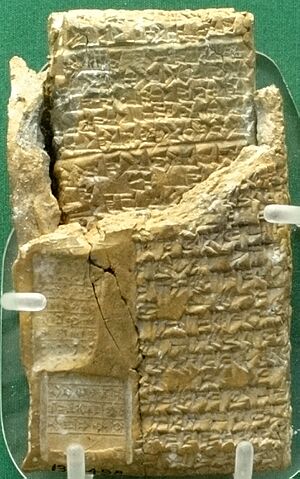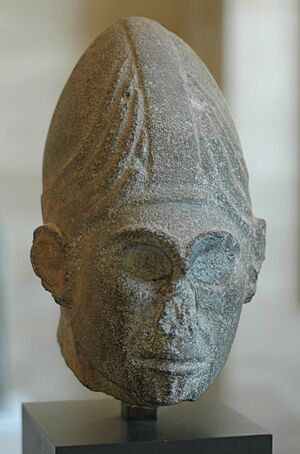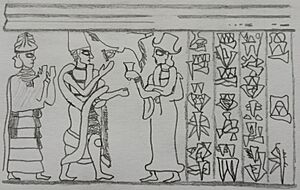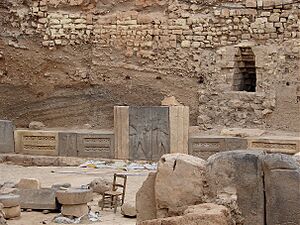Yamhad facts for kids
Quick facts for kids
Yamhad
Halab
|
|||||||||
|---|---|---|---|---|---|---|---|---|---|
| c. 1810 BC–c. 1517 BC | |||||||||
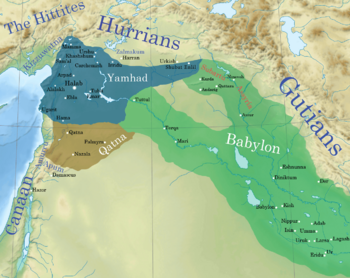
Yamhad at its greatest extent c. 1752 BC
|
|||||||||
| Capital | Halab | ||||||||
| Common languages | Amorite Hurrian (among Hurrians) |
||||||||
| Religion | ancient Levantine religion (Hadad was the chief deity) | ||||||||
| Government | Absolute monarchy | ||||||||
| King, Great King. | |||||||||
|
• c. 1810 – c. 1780 BC
|
Sumu-Epuh | ||||||||
|
• c. 1780 – c. 1764 BC
|
Yarim-Lim I | ||||||||
|
• mid. 16th century BC – c. 1524 BC
|
Ilim-Ilimma I | ||||||||
| Historical era | Bronze Age | ||||||||
|
• Established
|
c. 1810 BC | ||||||||
|
• Disestablished
|
c. 1517 BC | ||||||||
| Area | |||||||||
| 1750 BC est. | 43,000 km2 (17,000 sq mi) | ||||||||
|
|||||||||
| Today part of | |||||||||
Yamhad (also spelled Yamḫad) was an ancient kingdom in Syria. It was home to people who spoke a Semitic language. The kingdom's main city was Ḥalab, known today as Aleppo. Yamhad started around 1810 BC. It was ruled by the Yamhad dynasty, a family of kings who used both their army and smart talks to make their kingdom bigger.
From the very beginning, Yamhad had to fight off powerful neighbors like Mari, Qatna, and the Old Assyrian Empire. But thanks to a strong king named Yarim-Lim I, Yamhad became the most powerful kingdom in Syria. By the mid-1700s BC, most of Syria was under Yamhad's control. This was either directly or through smaller kingdoms that followed Yamhad's lead. For about 150 years, Yamhad was in charge of northern, northwestern, and eastern Syria. It even had influence over smaller kingdoms in Mesopotamia. The powerful Hittites eventually destroyed Yamhad. Later, the kingdom of Mitanni took over in the 1500s BC.
Most people in Yamhad were Amorite, and they had a typical Bronze Age Syrian way of life. Many Hurrian people also lived in Yamhad. They brought their own culture, which mixed with the local ways. Yamhad was a big trading hub, connecting the Iranian plateau in the east with the Aegean Sea region in the west. The people of Yamhad worshiped traditional Northwest Semitic gods. Their capital city, Halab, was a holy city. It was a main center for worshiping Hadad, who was seen as the most important god in northern Syria.
Contents
History of Yamhad
Not much of ancient Halab has been dug up by archaeologists. This is because the modern city of Aleppo sits right on top of the old one. So, most of what we know about Yamhad comes from clay tablets. These tablets were found in other ancient cities like Alalakh and Mari.
How Yamhad Began
The name Yamhad was probably the name of an Amorite tribe. It was often used to mean the same thing as Halab when talking about the kingdom. The city of Halab was a very important religious place in northern Syria. It was mentioned as "Ha-lam" and was part of the Eblaite empire around 2500 BC. Halab's fame as a Holy City helped it become important later. The main temple for the North Syrian storm god Hadad was in the city. People called Halab the "City of Hadad."
The names Halab and Yamhad first appeared during the Old Babylonian period. Sumu-Epuh was the first king of Yamhad. His name was found on a seal from Mari. It showed him as the ruler of the land of Yamhad. This land included Halab, Alalakh, and Tuba. Sumu-Epuh made his kingdom strong. He faced Yahdun-Lim of Mari, who first made a deal with Yamhad against Assyria. But then Yahdun-Lim attacked the north, threatening Yamhad. Sumu-Epuh helped the Yaminite tribes and made friends with other Syrian states. These included Urshu, Hassum, and Carchemish. They all stood against the Mariote king. Yahdun-Lim defeated his enemies, but his own son, Sumu-Yamam, later killed him.
Battles with Assyria and Growth
The rise of Shamshi-Adad I of Assyria was a bigger danger to Yamhad than Mari had been. This Amorite king of Assyria wanted to rule all of Mesopotamia and the Levant. He even called himself "king of the world." Shamshi-Adad surrounded Yamhad. He made alliances with Carchemish, Hassum, and Urshu to the north. He also conquered Mari to the east. This forced Zimri-Lim, the heir of Mari, to run away. Sumu-Epuh welcomed Zimri-Lim. He planned to use him against Assyria, since Zimri-Lim was the rightful ruler of Mari.
Shamshi-Adad's most dangerous alliance was with Qatna. Its king, Ishi-Addu, became Assyria's helper near Yamhad's borders. He married his daughter to Yasmah-Adad, the son of the Assyrian king. Yasmah-Adad was made king of Mari by his father. Sumu-Epuh was likely killed while fighting Shamshi-Adad. His son, Yarim-Lim I, took over. Yarim-Lim made his father's kingdom even stronger. He turned it into the most powerful kingdom in Syria and northern Mesopotamia. Yarim-Lim made alliances with Hammurabi of Babylon and Ibal-pi-el II of Eshnunna. Then, in 1777 BC, he moved east. He conquered Tuttul and made Zimri-Lim its governor. The Assyrian king died a year later. Yarim-Lim then sent his army with Zimri-Lim. They helped Zimri-Lim get his family's throne back in Mari. This made Mari an ally and a follower of Yamhad. They made their bond stronger when Zimri-Lim married Shibtu, Yarim-Lim's daughter.
Yarim-Lim spent the next years making his kingdom bigger. It reached Mamma in the north. He brought other Syrian city-states under his control, either by making friends or by force. Mamma, Ebla, and Ugarit became followers of Yamhad. Qatna stayed independent but made peace with Yamhad after Shamshi-Adad I died. A clay tablet found in Mari shows Yarim-Lim's mix of talking and fighting. It was sent to the king of Dēr in southern Mesopotamia. The tablet declared war on Der and its neighbor Diniktum. It also said that 500 Yamhadite warships were stationed in Diniktum for twelve years. And Yamhad helped Der militarily for 15 years. Yarim-Lim's achievements made Yamhad a "Great Kingdom." The Yamhadite king was then called the "Great King."
Yarim-Lim I's son, Hammurabi I, became king after him. His reign was peaceful. He managed to make Carchemish obey him. He also sent soldiers to help Hammurabi of Babylon against Larsa and Elam. This alliance ended after the Babylonian king attacked and destroyed Mari. But Babylon did not attack Yamhad. The two kingdoms stayed peaceful later on. Mari's fall left a power gap. This allowed Hammurabi to extend Yamhad's power over the upper Khabur valley in the east. The ruler of Shubat Enlil became his follower. Hammurabi I's son, Abba-El I, became king next. During his rule, the city of Irridu rebelled. It was under the control of Prince Yarim-Lim, Abba-El's brother. The king destroyed Irridu to stop the rebellion. He then gave his brother the throne of Alalakh as a new kingdom. This created a new branch of the royal family.
Yamhad's Decline and End
We don't have much information about the kings who came after Abba-El I. By the time Yarim-Lim III was king in the mid-1600s BC, Yamhad's power was weaker. This was due to problems inside the kingdom. Yarim-Lim III ruled a kingdom that was not as strong. Even though he made Qatna follow Yamhad, the weakness was clear. Alalakh had become almost independent under its own king, Ammitakum. Despite this, the king of Yamhad was still the strongest among the Syrian states. The Hittites called him a Great King, meaning he was equal to their own king.
The growing power of the Hittite kingdom in the north was the biggest threat to Yamhad. But Yarim-Lim III and his son Hammurabi III were able to fight off the attacks of the Hittite king Hattusili I. They did this by making friends with Hurrian rulers. Hattusili chose not to attack Halab directly. Instead, he started by conquering Yamhad's followers and friends. He took Alalakh around 1650 BC. Hattusili then attacked the Hurrians in Urshu, northeast of Halab. He won, even though Halab and Carchemish sent help to the Hurrians. The Hittite king then defeated Yamhad in the battle of Mount Atalur. He also destroyed Hassum and several other Hurrian cities. After many fights, Hattusili I finally attacked Halab during Hammurabi III's rule. The attack failed. The Hittite king was hurt and died later around 1620 BC. Hattusili's attacks made Yamhad much weaker. Its king was no longer called a "Great King."
Hattusili's grandson, Mursili I, became king after him. Mursili conquered Halab around 1600 BC. He destroyed Yamhad as a major power in the Levant. Mursili then went to Babylon and attacked it. But he was killed when he returned to his capital, Hattusa. His empire then fell apart. Halab was rebuilt, and the kingdom grew to include Alalakh again. The kings of this new kingdom are only known by their names. The first was Sarra-El, who might have been Yarim-Lim III's son. The last king of this family to rule Halab was Ilim-Ilimma I. His rule ended around 1524 BC when he was killed during a rebellion. This rebellion was started by King Parshatatar of Mitanni, who then took over Halab. Ilim-Ilimma's son, Idrimi, ran away to Emar. He then conquered Alalakh around 1517 BC. Seven years after taking Alalakh, Idrimi made peace with Mitanni. He became a follower of Mitanni and was allowed to control Halab. But he had to move his family's home to Alalakh and could no longer use the title "King of Halab." The name Yamhad also stopped being used.
Kings of Yamhad: Who Ruled?
The dates below are estimates based on the Middle chronology.
| King | Reigned | Title | Relation to Previous King |
|---|---|---|---|
| Sumu-Epuh | c. 1810 BC – c. 1780 BC | King | |
| Yarim-Lim I | c. 1780 BC – c. 1764 BC | Great King | Son. |
| Hammurabi I | c. 1764 BC – c. 1750 BC | Great King | Son. |
| Abba-El I | c. 1750 BC – c. 1720 BC | Great King | Son. |
| Yarim-Lim II | c. 1720 BC – c. 1700 BC | Great King | Son. |
| Niqmi-Epuh | c. 1700 BC – c. 1675 BC | Great King | Son. |
| Irkabtum | c. 1675 BC – Mid-17th century BC | Great King | Son. |
| Hammurabi II | Mid-17th century BC | Great King | Possible brother. |
| Yarim-Lim III | Mid-17th century BC – c. 1625 BC | Great King | Brother of Irkabtum. |
| Hammurabi III | c. 1625 BC – c. 1600 BC | King | Son. |
| Sarra-El | Early 16th century BC | King | Possible son of Yarim-Lim III. |
| Abba-El II | Mid-16th century BC | King | Son. |
| Ilim-Ilimma I | c. 1524 – c. 1517 BC | King | Possible son. |
People and Culture
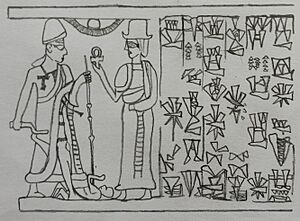
The people of Yamhad were mostly Amorites and spoke the Amorite language. Yamhad's culture was typical of the Middle Bronze Age in Syria. It had only a few influences from Mesopotamia, Egypt, and the Aegean Sea region. This culture affected how temples were built and used. Temples were mainly for worship. Political power was held in the royal palace. This was different from Mesopotamia, where temples had a big political role.
Since the capital city of Halab has not been dug up, we learn about the kingdom's buildings from Alalakh. Alalakh was a city under Halab's control. It was ruled by a king from Yamhad's royal family. Amorites often built large palaces. These palaces looked similar to old Babylonian palaces. They had big central courtyards, throne rooms, tiled floors, drainage systems, and plastered walls. This shows that skilled workers were used. There is also proof that artists from Minoan Aegean painted detailed scenes on the walls of the palaces in Alalakh.
Yamhad had its own special Syrian art style. This is clear in the seals of the kings, which showed Syrian gods. Egyptian influence was small. It was mostly seen in the use of the ankh symbol. This symbol was not used to copy Egyptian rituals. It was just a different way to show the cup that a god usually held. Yamhad had a unique trim pattern called the Yamhad style. This style was popular in Mari when King Zimri-Lim ruled. His queen, Shibtu, was the daughter of Yarim-Lim I.
After the Akkadian Empire fell, Hurrians started to settle in Halab and nearby areas. By around 1725 BC, they made up a large part of the population. Having many Hurrians brought Hurrian culture and religion to Halab. We know this because some religious festivals had Hurrian names. Later, Hurrians began to see their main god, Teshub, as the same as Hadad. So, Hadad became Teshub, the Storm-God of Halab.
Economy and Trade
Halab's location has always made it an important place for trade. Yamhad's economy relied on trading with the Iranian Plateau, Mesopotamia, Cyprus, and Anatolia. The city of Emar was its port on the Euphrates River. Alalakh, being close to the sea, was its port on the Mediterranean Sea.
King Yarim-Lim I's actions and his alliance with Babylon were very important for Yamhad's economy. They made trade safe between Mesopotamia and northern Syria. The king of Mari protected the trade groups traveling from the Persian Gulf to Anatolia. Many Babylonian merchants came to Emar. They lived in the city and had a lasting effect on how local scribes wrote. Even as late as the 1300s BC, texts from Emar still showed clear Babylonian influences.
Yamhad's markets were a source of copper. Copper was brought in from the mountains (likely in Anatolia) and from Cyprus. However, Babylon's attack on Mari hurt trade between the two kingdoms. The trade route became dangerous because Mari could no longer protect the caravans. This led the Babylonian king Samsu-iluna to build many forts along the river valley. He also set up groups of hired soldiers called "Kassite Houses" to protect the middle Euphrates area. These groups later became semi-independent states. They fought against the Babylonian king Ammi-Saduqa, which temporarily stopped trade.
Religion and Gods
The people of Yamhad followed the Amorite religion. They mainly worshiped the gods of the Northwest Semitic people. The most important gods were Dagon, who was seen as the father of the gods, and Hadad. Hadad was the most important god and the leader of all the gods. The kingdom was known as the "land of Hadad." He was famous as the Storm-God of Halab starting in the mid-2000s BC. His main temple was on the citadel hill in the center of the city. It was used from the 2300s BC until at least the 800s BC.
"Beloved of Hadad" was one of the king's titles. Hadad was the kingdom's special protector god. All agreements were made in his name. His name was also used to threaten other kingdoms and to declare wars. As more Hurrians came, their religious ideas also grew. Some Hurrian gods became part of Yamhad's group of gods. King Abba-El I mentioned getting help from the Hurrian goddess Hebat in one of the Alalakh tablets. Hebat was the wife of the main Hurrian god Teshub. But in Abba-El I's tablet, she is linked with Hadad.
Besides the general gods, kings also had a "head god." This was a god who had a very close connection to the worshiper. King Yarim-Lim I said Hadad was the god of the state. But he said the Mesopotamian god Sin was the god of his head. His son Hammurabi I did the same.
See also
- Armi
- Yamhad dynasty
- List of rulers of Aleppo


